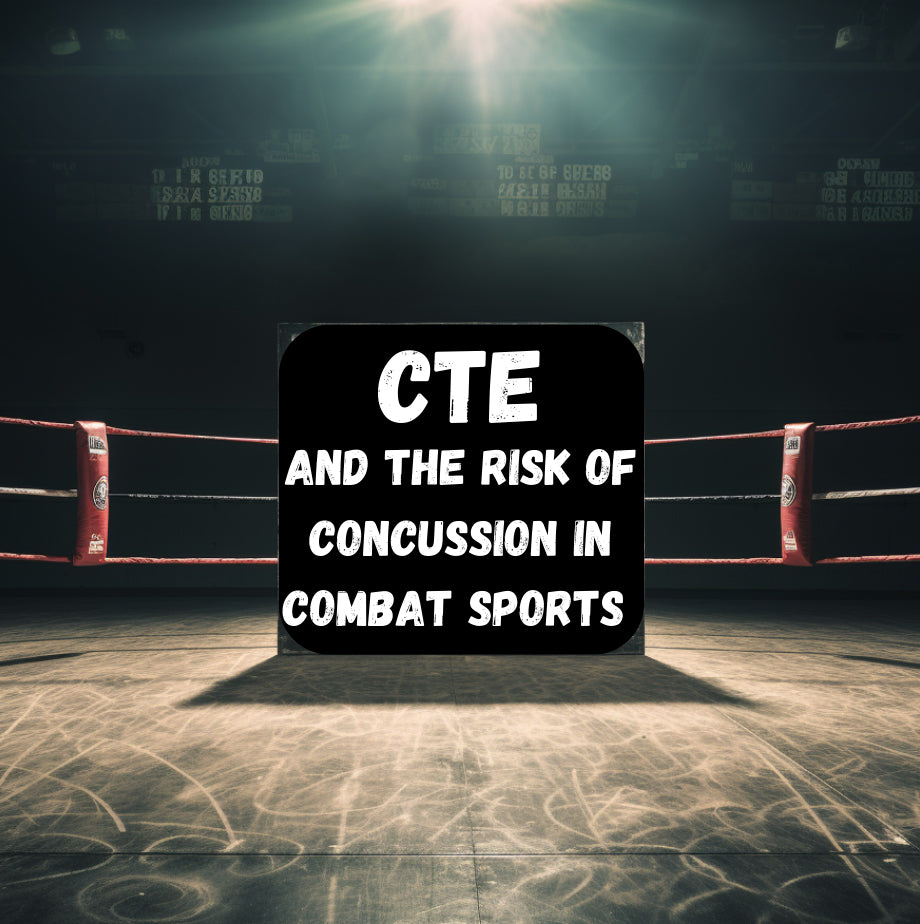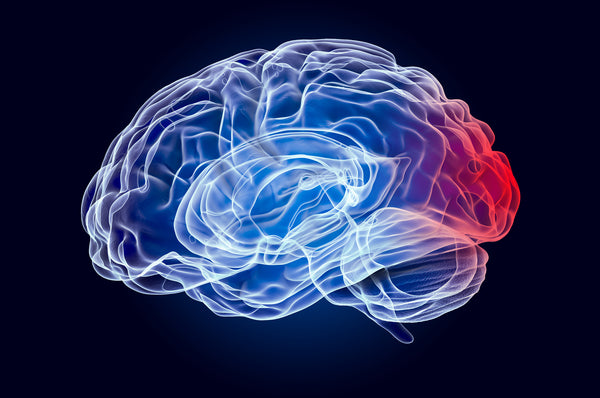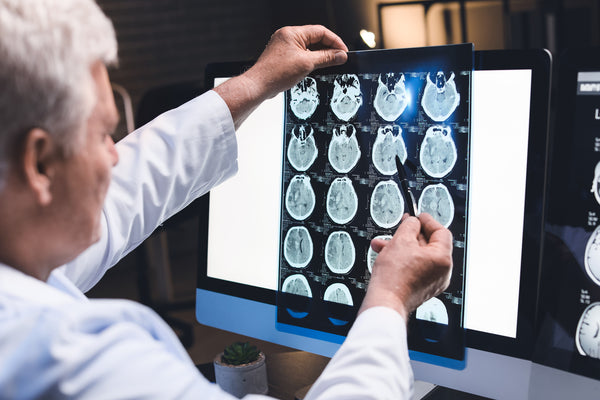
Concussion and CTE in Martial Arts and Combat Sports - What Should You Be Aware Of?
Through my #InsideChat podcast, I am able to personally speak with a wide range of leading figures from the world of martial arts, sports, psychology, sociology and nutrition on a regular basis. Two such individuals I had the pleasure of speaking to and learning from recently are internationally renowned Molecular Neuroscientist, Dr Valentina Di Pietro of the university of Birmingham, and former Kickboxing world champion Gary Turner. In both of our discussions we spoke at length about the real risks raised by concussion and CTE in Martial Arts and Combat Sports.
Head trauma in combat sports can cause short and long-term consequences that are still underestimated by many participants. Increasing medical evidence shows that concussions and cumulative sub-concussive blows lead to neurological damage associated with elevated risk of cognitive decline and neurodegenerative disease later in life.

In this extensive post written up from these talks, we look into the latest research on concussion and repetitive head impacts in order to help bring much needed awareness to the martial arts and combat sports communities. This post aims to provide the essential knowledge participants, coaches and parents must know so that they can make better informed decisions and advocate for greater safety.
Defining Concussion in Combat Sports
So what exactly constitutes a concussion? Dr. Di Pietro explains it as a traumatic brain injury caused by an impact to the head that shakes the brain, creating neurometabolic and neurochemical changes. This temporarily disrupts normal brain cell functioning. While termed "mild" TBI, concussions can have serious effects and complications if not managed properly.
Common symptoms include headache, dizziness, nausea, confusion, blurred vision, balance problems, difficulty concentrating and slowed reaction times. Symptoms may not appear immediately and can persist for weeks or months, emphasizing the need for diligent monitoring. Detailed return to activity protocols focusing on complete rest and gradual reintroduction of cognitive and physical exertion are essential to ensure the brain fully recovers before risking further injury.

Dr. Di Pietro notes diagnosis remains challenging without an objective biomarker test. Currently identification relies on reported symptoms plus cognitive and neurological screening. Research at her lab at the University of Birmingham aims to discover diagnostic biomarkers in saliva to more definitively diagnose concussion. This would aid medical decisions on removing athletes from play until recovered, as concussion substantially elevates injury risk if a second impact occurs before the brain has healed.
Cumulative Impacts & Chronic Traumatic Encephalopathy
While single concussions can have serious consequences, repetitive sub-concussive and concussive blows over a career pose the greatest danger. Dr. Di Pietro explains that with each head impact, structural damage and neurometabolic/neurochemical changes occur which disrupt cell functioning. If hits are repeated before complete recovery, effects compound causing progressive, cumulative neurological damage.
This increases susceptibility to severe injury and accumulating dysfunction can eventually manifest in cognitive, behavioral and motor impairment over the short and long-term. Research shows those exposed to more head trauma face earlier onset and accelerated development of neurodegenerative disorders like Chronic Traumatic Encephalopathy (CTE), Alzheimer’s, Parkinson’s and ALS later in life.

CTE represents the prime neurological danger of repetitive brain trauma. Initially termed concepts like "punch drunk syndrome", it is a progressive degenerative disease found in boxers and other athletes with notable head impact exposure, including football, hockey, rugby and wrestling participants.
Gary notes CTE shares extensive pathological similarities with Alzheimer's disease, though it can manifest decades earlier in life. Characterised by accumulation of toxic tau proteins resulting from injury, CTE progressively destroys brain tissue leading to symptoms like memory loss, confusion, impaired judgement, aggression, depression, movement disorders and eventually overt dementia.
Dr. Di Pietro explains that cumulative sub-concussive and concussive damage increases risk of developing CTE and other neurological disorders. Genetic factors also play a role. Exact risk percentages are hard to pinpoint given difficulty diagnosing CTE until examining the brain posthumously. But clearly more head trauma correlates to elevated incidence of neurodegenerative decline.
This danger is likely still underestimated due to limited epidemiological research. Gary emphasises that while exact percentages are debated, boxing has an undisputed and exceptionally high CTE risk, warranting major reforms. More data from other combat sports is still needed. However, the research trajectory indicates much lower head trauma exposure thresholds for developing CTE than previously assumed.
Short-Term Dangers: Second Impact Syndrome
While CTE manifests later in life, concussions also pose immediate dangers if not managed properly. Dr. Di Pietro notes that during the metabolic dysfunction following a concussion, the brain is extremely vulnerable to further injury. A second impact before full recovery can result in severe swelling, brain bleeding and elevated intracranial pressure causing respiratory failure, seizures, coma or even death.

This “second impact syndrome” has led to fatalities in boxing and other contact sports when appropriate medical steps weren't taken after potential concussions. Dr. Di Pietro stresses the critical need for competent ringside medical professionals empowered to halt bouts based on possible concussion. Standing eight counts after knockdowns or heavy blows allow evaluation before continuing.
Effective Concussion Management in Combat Sports
So what are the key elements of an effective concussion management protocol in martial arts and combat sports? Dr. Di Pietro emphasizes comprehensive baseline testing plus careful monitoring. At minimum, properly trained medical staff must be present ringside/matside to identify signs like loss of consciousness, balance problems, confusion, repetitive questioning or vomiting warranting immediate removal for assessment.
She advocates introducing independent spotters solely looking for concussion red flags others may miss when caught up in the action. Ensuring qualified on-site evaluation and urgent hospital referral for neurological work up if warranted is essential. This includes scanning for brain bleeds that may require neurosurgery. Wherever safety is compromised by lack of appropriate medical care, events simply shouldn't take place.

Following potential concussion, athletes should completely rest cognitively and physically for 24-48 hours with progressive reintroduction of school/work demands before gradual return to training. Full recovery can take weeks to months depending on severity. Patience is key - research shows adolescence requires longer concussion recovery. Return to contact risk before full healing substantially elevates reinjury and neurological complications.
Gary argues overhaul is urgently needed in boxing and other combat sports to properly implement informed, strict medical protocols. He notes fighters exhibiting clear concussion symptoms like balance problems shockingly still enter later bouts at major competitions, representing a grave failure of duty of care. This will inevitably result in preventable tragedies and massive litigation if governance does not modernise.
Creating a “Brain Health” Culture
Both Dr. Di Pietro and Gary emphasise a cultural shift focusing on “brain health” is required to motivate changes. Concussion management must become a top priority with competent policies and medics present at all events. Coaches need education to recognise and respond appropriately to potential brain injuries.
Athletes should undergo regular neurological screening to enable prompt identification and management of concussions. Dr. Di Pietro stresses the key is recognising when a concussion may have occurred and managing it appropriately through complete rest and gradual return to sport.
Gary advocates honesty about risks when athletes enter contact disciplines so they can provide fully informed consent. He argues coaches must move from traditional “tough it out” mindsets to embracing safety protocols that preserve the sport they love while optimising human performance, not compromising it. Promoting open discussion and continued learning, not macho posturing, empowers this cultural shift.
Youth Concussion Risks in Martial Arts & Combat Sports
The developing brains of children and adolescents are especially susceptible to traumatic injury and require very careful management. Gary stresses unequivocally that allowing any head contact in youth combat sports represents child abuse given what is now medically understood. Leading policy definitions in the UK classify it as such.
Until the mid twenties when the brain fully matures, the youth concussion recovery process requires extra caution. Dr. Di Pietro notes those under 18 will generally take longer to fully rehabilitate before safely returning to contact. Even small cognitive or exertional challenges can overwhelm their recovery when jumping back into activities too soon.
Ensuring kids aren’t pressured to return prematurely is imperative - full healing timeframes should be mandated. Certain combat sports have been slow to limit head trauma in youth participation. But growing medical consensus favours delays to introduce head contact until late adolescence at minimum.
Until then, strict avoidance is advised by experts like Gary given heightened consequences of head impacts on the developing brain. Where limited contact is absolutely necessary for skill development, every precaution must be taken to avoid significant force and prevent cumulative exposure.
Sociocultural Change Needed to Prioritise Safety
Gary argues wider sociocultural changes are required in martial arts and combat sports to align with current medical knowledge on concussion and TBI. Stakeholders from coaches and promoters to referees and ringside doctors must take greater accountability for preventing unnecessary trauma.
He indicates those shining light on uncomfortable truths are often attacked rather than engaged in honest dialogue. Vested interests deny emerging evidence and try justifying the troubling status quo. However, wilful ignorance will only make those vulnerable to grave legal and ethical consequences once the tide of public opinion shifts further.
He emphasises reforms should be proactive, not reactive due to litigation and bans. Implementing greater precautions like updated concussion protocols, enhanced medical oversight, modified training, stricter youth head contact limits and improved coaching education will preserve combat sports for the next generation. Those unwilling to embrace safety advances risk sports like boxing losing hard-won social sanction.
Optimising Training Methods to Limit Head Impacts
Within training, certain traditional practices clearly require broad re-evaluation in light of head trauma research. Gary pinpoints excessive, poorly managed sparring as particularly problematic - coaches must move beyond an ingrained "no pain, no gain" mentality. Sparring undoubtedly hones skills, but should use the least force viable to confer benefit.

Rather than prizing the ability to take blows, smart preparation prioritises deft evasion. Learning to intelligently absorb or divert strikes matters, but drills incentivising accumulation of needless trauma must end. The mindset change required is analogous to differences between sustainable and exploitative environmental resource use - conserve brain health for longevity rather than recklessly exhausting it in youth.
Gary advocates various emerging training modalities to gain technical, tactical and mental preparedness while radically reducing concussive and sub-concussive damage accrued. For example, he employs slow-motion sparring where partners move at 5-25% normal speed to heighten perception and fine-tune responses, yet keep impact forces negligible.
Other options include stopping strikes millimeters short of contact to practice realistic flinch responses and emphasise evasion. Regular interval training in “fresh air” develops situational footwork and elusiveness. Where some contact is warranted for conditioning, use standing eight counts, minimize power and prevent excessive accumulation. Creativity allows preserving core sparring benefits without its worst harms.
Gary also indicates emerging technology like accelerometer-embedded gum shields could be integrated into contact training and competition. These monitor individual and cumulative impact forces to the head in real time, providing data to refine safety. Metrics can inform personalised recovery periods and prompt medical evaluation when concerning thresholds are exceeded. Technology promises to potentially aid the cultural shift needed.
Watch and Listen to the full podcast between myself and Dr Valentina Di Pietro below
Watch and Listen to the full podcast between myself and Gary Turner below
What Parents Must Know About Youth Participation in Combat Sports
Ultimately parents shoulder immense responsibility for managing youth participation risks in activities like Boxing, Kickboxing, Muay Thai, Karate and MMA.
What key knowledge should shape their decisions?
Firstly, contrary to many assumptions, allowing any child head contact potentially constitutes maltreatment given evidence that even mild blows create structural changes in the developing brain. While some sports lag behind, certain regulators in the martial arts world already prohibit youth head contact. This could one day become required best practice.
Secondly, no coach can guarantee avoidance of accidental head contact in grappling, sparring or competition. So even comparatively lighter contact martial arts carry inherent risks. The onus lies with parents to determine acceptable risk levels for their child before permitting enrollment.
Thirdly, any exposure necessitates stringent concussion education and monitoring. Be alert for symptoms like headache, dizziness or emotional changes after sessions and inform coaches/doctors at the earliest sign. Request details on their TBI identification and management protocols. Push for improvements if lacking.
Fourthly, talk to children about honestly conveying any symptoms experienced and encouraging teammates to do the same. Foster an understanding that their safety is more important than pleasing coaches or parents by downplaying worrisome head blows. open communication helps nip developing issues in the bud.
Finally, carefully weigh short-term performance gains against long-term neurological health. Prioritise development of discipline, character and wellbeing over pressuring wins and progression if permitting youth combat sports enrollment at all. With the right approach, these activities offer much value, but ensuring brain health remains paramount.
Final Thoughts for Those Involved in Combat Sports
Dr Di Pietro and Gary Turner conclude that the key points those involved in Martial Arts, Boxing, Kickboxing, Muay Thai and other combat disciplines should bear in mind are:
- Repetitive minor head blows cumulatively inflict neurological trauma, increasing later neurodegenerative disease risk.
- Single and multiple concussions can have severe acute consequences like death if mismanaged. Avoid second impact at all costs.
- Develop strict TBI protocols and competent medical oversight at all events - this is a fundamental duty of care.
- Coaches require much greater concussion education to reform practice and response.
- Allowing youth head blows could potentially be classed as abuse given documented developmental harms. Acceptable exposure is vanishingly minimal at best.
- Training should be optimised to confer benefit without inflicting brain trauma. Embrace new training methods where required to achieve this.
- Athletes must be fully informed on concussion and CTE risks when commencing contact disciplines as minors or adults.
- A cultural shift prioritising “brain health” is required to make combat sports safer moving forward.
They agree that blindly denying the growing medical consensus is no longer tenable. Those who truly care for the longevity of cherished combat sports like Boxing and Muay Thai must act decisively - or public backlash and catastrophic human costs may render the point moot. With smart reforms, martial arts can provide therapeutic outlets and valuable character development for generations to come.
Dr Di Pietro is a Molecular Neuroscientist with a MSc in Molecular Biology, a PhD in Clinical Biochemistry and a further degree in Medical Genetics.
With almost 20 years of research experience with particular interest in the molecular mechanisms of TBI, she is an expert of in vitro and in vivo animal models of TBI. She currently leads the research efforts on microRNA signatures in biofluids to diagnose mild and severe TBI in patients.
As the recipient of the prestigious BRIDGE Fellowship in Brain Trauma, she is a Research Fellow at the Institute of Inflammation and Ageing of the University of Birmingham (UK), collaborating with the Beckman Institute at the University of Illinois, Urbana-Champaign (USA) on TBI neuroimaging research.
FIND VALENTINA ON TWITTER: @valentinaTBI
DR DI PIETRO UNIVERSITY OF BIRMINGHAM: How to contact
Former Kickboxing World Champion Gary Turner is a widely regarded PHD student in behaviour and head trauma.
FOLLOW GARY TURNER ON INSTAGRAM: @smilerturner
WEBSITE: www.garyturnerperformance.teachable.com
Related Content
If you enjoy this article on Concussion and CTE in Martial Arts and Combat Sports then you may well love Motivating Fighters and Developing Mental Toughness in Martial Arts and Combat Sports or 19 Ways to Become a World Champion in Coaching Martial Arts and Combat Sports as already featured on this site.
Warrior Marketplace
Here, you can also learn more about all of the other exceptional exceptional Muay Thai, Kickboxing, Boxing, Karate and Taekwondo Instructional Volumes featured on the Warrior Collective!
Thanks for reading, I hope you enjoyed reading this article on How to train Muay Thai on your own without a coach or training partner, please like, share and don't forget to subscribe to the Warrior Collective Youtube Channel for great training videos each week!!
Keep up to date with the Warrior Collective
